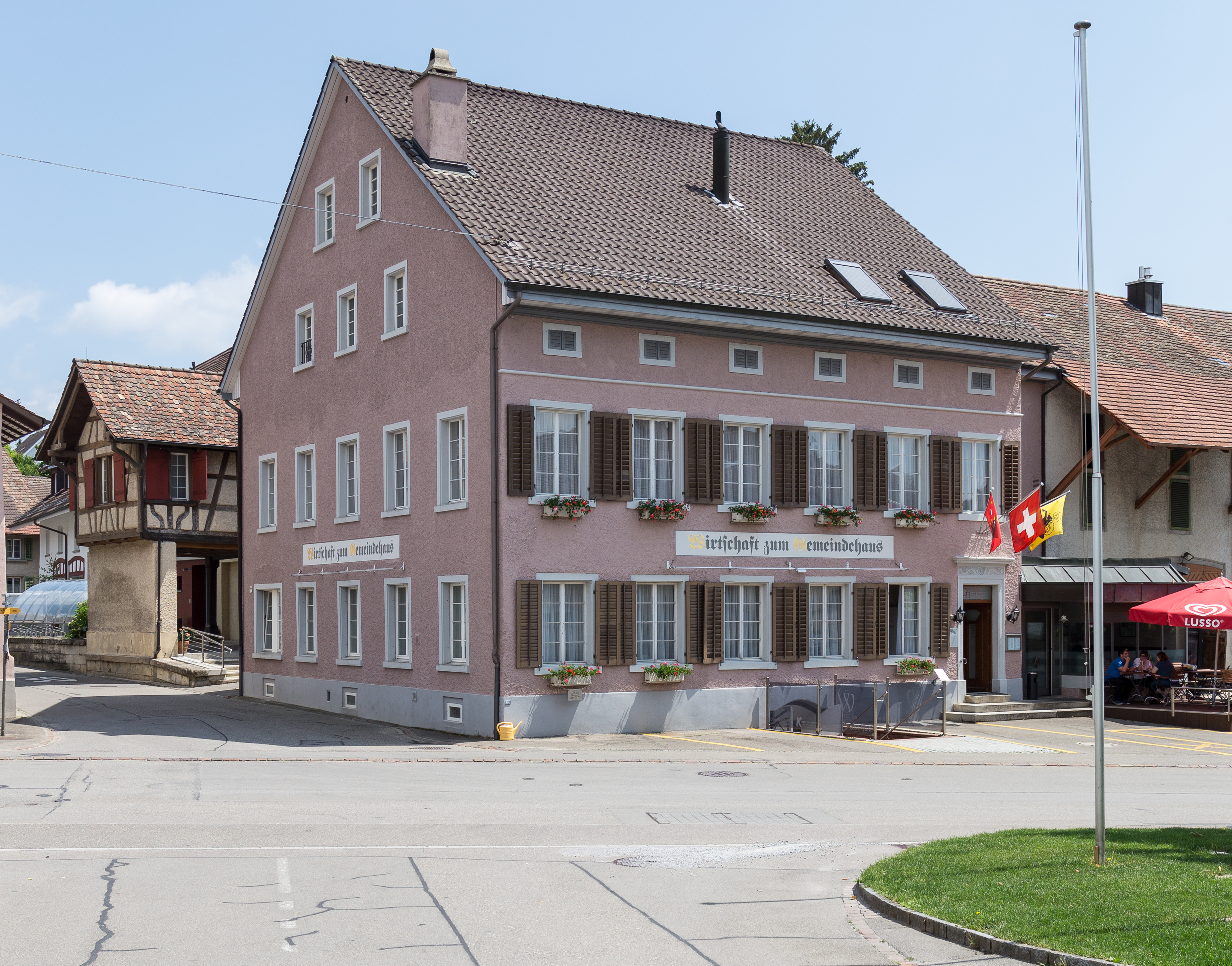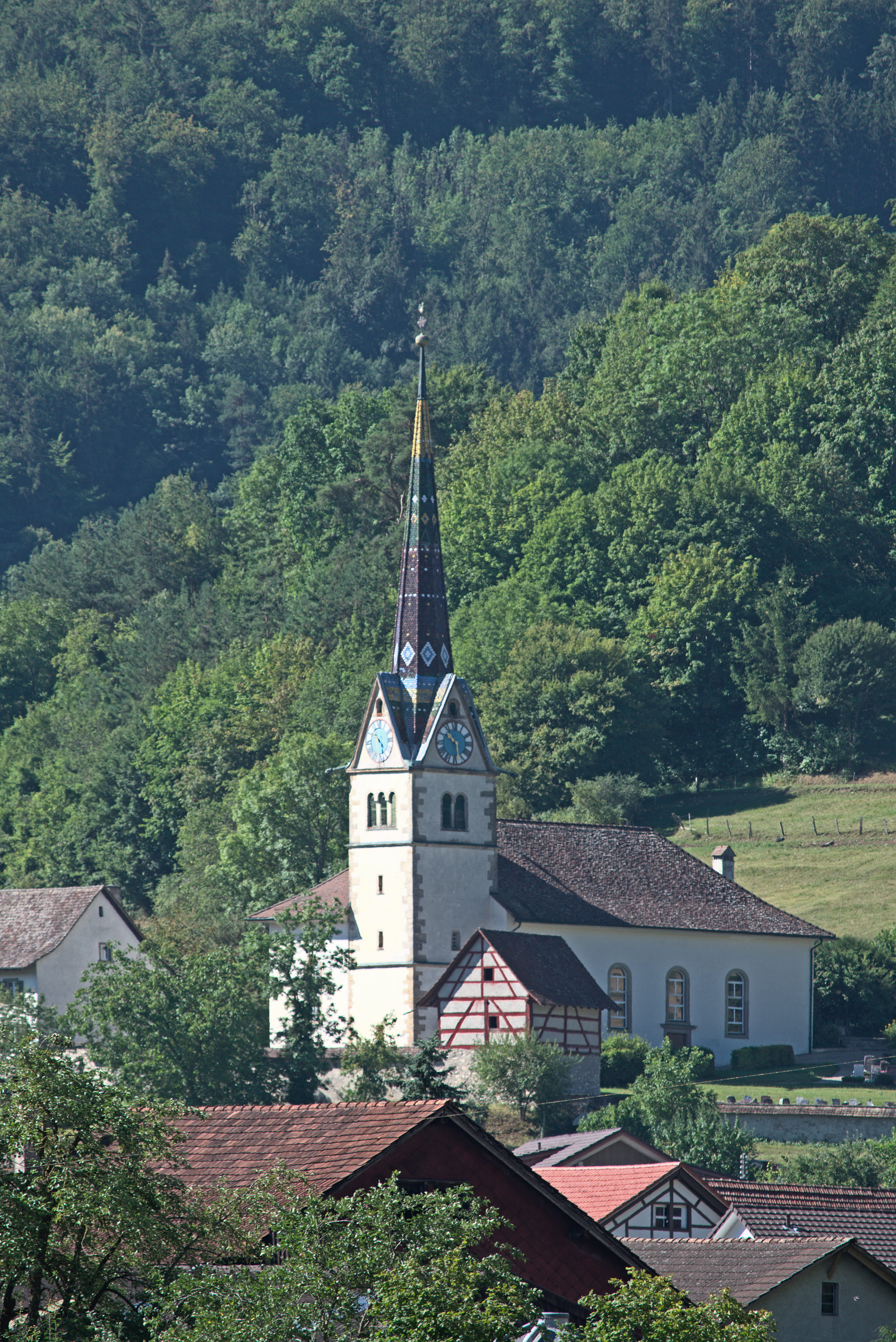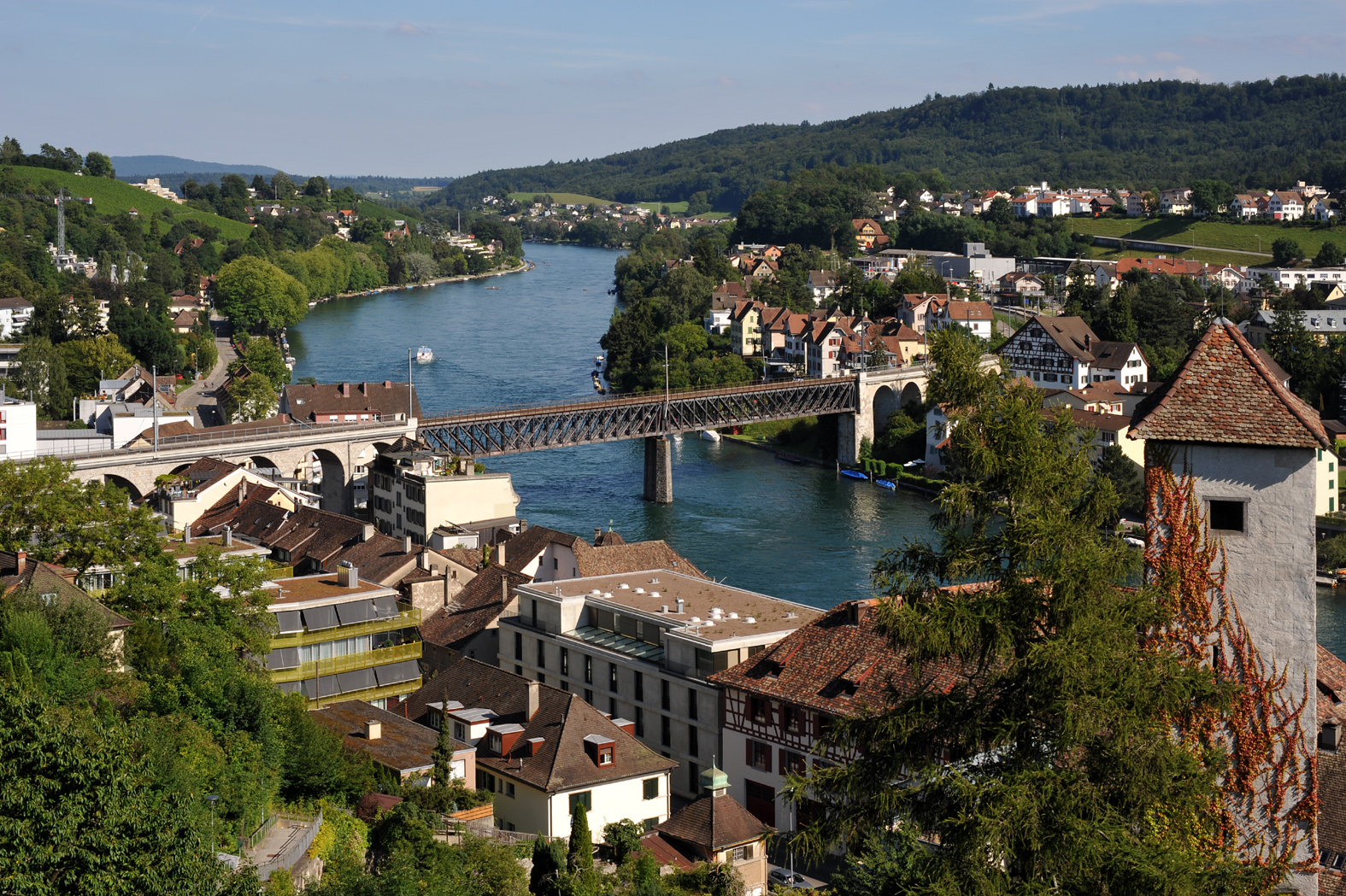|
Schaffhausen
Schaffhausen (; gsw, Schafuuse; french: Schaffhouse; it, Sciaffusa; rm, Schaffusa; en, Shaffhouse) is a town with historic roots, a municipality in northern Switzerland, and the capital of the canton of the same name; it has an estimated population of 36,000 It is located right next to the shore of the High Rhine; it is one of four Swiss towns located on the northern side of the Rhine, along with , the historic , and . The old town has many fine Renaissance era buildings decorated with exterior frescos and sculpture, as well as the old canton fortress, the ''Munot''. Schaffhausen is also a railway junction of Swiss and German rail networks. One of the lines connects the town with the nearby Rhine Falls in , Europe's largest waterfall, a tourist attraction. The official language of Schaffhausen is (the Swiss variety of Standard) German, but the main spoken language is the local variant of the Alemannic Swiss German dialect. Name The town is first mentioned in 1045 ... [...More Info...] [...Related Items...] OR: [Wikipedia] [Google] [Baidu] |
Neuhausen Am Rheinfall
Neuhausen am Rheinfall (sometimes abbrv. as Neuhausen a. Rhf., called Neuhausen until 1938) is a town and a municipality in the canton of Schaffhausen in Switzerland. The town is close to the Rhine Falls, a tourist attraction and mainland Europe's largest waterfall. History Neuhausen am Rheinfall is first mentioned in 900/910 as ''Niuhusen''. In 1253 it was mentioned as ''Niuwenhusin''. Coat of arms The German blazon reads: ''In gelb über grünem Kleeblatt weisses nach rechts gekehrtes Rebmesser mit braunem Griff.'' The municipality's arms might in English heraldic language be described thus: Or in base a cloverleaf couped proper above which a billhook argent hafted proper. In 1569, Neuhausen bore arms with a gold field and a leaping silver salmon. This symbolized the importance of fishing to the municipality. Shortly thereafter, the arms appeared with different tinctures; the field was now red. With the lessening importance of fishing, the arms, too, presumably ended up bein ... [...More Info...] [...Related Items...] OR: [Wikipedia] [Google] [Baidu] |
Thayngen
Thayngen () is a village and a municipality in the canton of Schaffhausen in Switzerland. On 1 January 2009 Altdorf, Bibern, Hofen, Opfertshofen merged into Thayngen.Amtliches Gemeindeverzeichnis der Schweiz published by the Swiss Federal Statistical Office accessed 23 September 2009 Geography  Thayngen has an area, , of . Of this area, 52.2% is used for agricultural purposes, while 28.9% is forested. Of the rest of the land, 17.1% is settled (buildings or roads) and the remainder (1.8%) is non-productive (rivers or lakes ...
Thayngen has an area, , of . Of this area, 52.2% is used for agricultural purposes, while 28.9% is forested. Of the rest of the land, 17.1% is settled (buildings or roads) and the remainder (1.8%) is non-productive (rivers or lakes ...
[...More Info...] [...Related Items...] OR: [Wikipedia] [Google] [Baidu] |
Beringen, Switzerland
Beringen is a municipality in the canton of Schaffhausen in Switzerland. On 1 January 2013 the municipality of Guntmadingen merged into the municipality of Beringen.Nomenklaturen – Amtliches Gemeindeverzeichnis der Schweiz accessed 9 February 2013 History Switzerland's history and Beringen's as well is linked back to the Ice Age and Stone Age. But, more specifically beginning with The Helvetians, a Celtic tribe, give their name to the Swiss territory: hence HELVETIA on Swiss flags, coins and stamps, ch = Confoederatio Helvetica on cars and internet domains. This is where the story and timeline of not only Swiss history but that of Berg ...[...More Info...] [...Related Items...] OR: [Wikipedia] [Google] [Baidu] |
Büttenhardt
Büttenhardt (pronunciation: ˈbʏttənˌhaɐt) is a municipality in the canton of Schaffhausen in Switzerland. History Büttenhardt is first mentioned in 1238 as ''Butinhart''. The village became part of Switzerland in the 14th century. The territory of the municipality of Büttenhardt today includes territory of Verenahof which formerly belonged to what was then West Germany. Verenahof (also known as ''Büttenharter Hof'' or ''Verenahöfe'') was a German exclave in Switzerland, administratively part of the West German town of Wiechs am Randen (which is now part of the town of Tengen). Geographically, it was separated from the rest of West Germany by a 200–300-metre wide strip of Swiss territory. In 1964 a treaty was concluded between West Germany and Switzerland, which entered into force on 4 October 1967. The 43-hectare territory, containing three houses and fewer than a dozen people, became part of Switzerland [...More Info...] [...Related Items...] OR: [Wikipedia] [Google] [Baidu] |
Büsingen Am Hochrhein
Büsingen am Hochrhein (, "Büsingen on the Upper Rhine"; Alemannic: ''Büesinge am Hochrhi''), commonly known as Büsingen, is a German municipality () in the south of Baden-Württemberg and an enclave entirely surrounded by the Swiss cantons of Schaffhausen, Zürich and Thurgau. It has a population of about 1,450 inhabitants. Since the early 19th century, the village has been separated from the rest of Germany by a narrow strip of land (at its narrowest, about wide) containing the Swiss village of Dörflingen. The distance to this enclave is approximately 5 km (3.1 mi) from the town of Schaffhausen and 3 km (1.8 mi) from Dörflingen, the nearest village. Politically Büsingen is part of Germany, forming part of the district of Konstanz, but economically it forms part of the Swiss customs union, along with the principality of Liechtenstein and up until 2019, albeit unofficially, the Italian village of Campione d'Italia. [...More Info...] [...Related Items...] OR: [Wikipedia] [Google] [Baidu] |
Merishausen
Merishausen is a municipality in the canton of Schaffhausen in Switzerland. History Merishausen is first mentioned in 846 as ''Morinishusun''. Coat of arms The blazon of the municipal coat of arms is ''Azure a Mullet Or.'' Geography Merishausen has an area, , of . Of this area, 30.3% is used for agricultural purposes, while 65.6% is forested. Of the rest of the land, 3.9% is settled (buildings or roads) and the remainder (0.2%) is non-productive (rivers or lakes). The municipality is located in the Schaffhausen district on the German border. It is located on the Durach river along an important trade route between southern Germany and Switzerland. Demographics Merishausen has a population () of 779, of which 10.0% are foreign nationals. Of the foreign population, (), 50% are from Germany, 10.9% are from Italy, and 39.1% are from another country. [...More Info...] [...Related Items...] OR: [Wikipedia] [Google] [Baidu] |
Stetten, Schaffhausen
Stetten is a municipality in the canton of Schaffhausen in Switzerland. Geography Stetten has an area, , of . Of this area, 45.6% is used for agricultural purposes, while 44.9% is forested. Of the rest of the land, 9.3% is settled (buildings or roads) and the remainder (0.2%) is non-productive (rivers or lakes). Coat of arms The blazon of the municipal coat of arms is ''Gules Moon increscent Or.'' Demographics Stetten has a population () of 1,084, of which 16.7% are foreign nationals. Of the foreign population, (), 47.3% are from Germany, 10.2% are from Italy, 2.7% are from Serbia, 0.5% are from Macedonia, 0.5% are from Turkey, and 38.7% are from another country.Statistical Office of the Canton of Schaffhausen accessed 2 December 2009 Over the last 10 years the population has grown at a rate of ... [...More Info...] [...Related Items...] OR: [Wikipedia] [Google] [Baidu] |
Hemmental
Hemmental was a municipality in the canton of Schaffhausen in Switzerland. In 2009 Hemmental merged with Schaffhausen.Amtliches Gemeindeverzeichnis der Schweiz published by the Swiss Federal Statistical Office accessed 23 September 2009 Hemmental was roughly outside of the city limits of Schaffhausen and away from the Schaffhausen train station. First Settlement It is generally accepted that Hemmental was settled between the 7th and 8th centuries by the . Local tradition states that the village was named after a Germanic priest probably named Hemo. According to the records of Burkhard of Nellenburg, in 1090 Hemo gave ...[...More Info...] [...Related Items...] OR: [Wikipedia] [Google] [Baidu] |
Dörflingen
Dörflingen is a village and a municipality in the canton of Schaffhausen in Switzerland. It borders a short strip of the north shore of the Rhine. History Dörflingen is first mentioned in 1264 as ''Dorfelingen''. Geography Dörflingen has an area, , of . Of this area, 64.3% is used for agricultural purposes, while 26.9% is forested. Of the rest of the land, 7.5% is settled (buildings or roads) and the remainder (1.4%) is non-productive (rivers or lakes). Dörflingen is located in the Reiat district, about east of Schaffhausen and has two separate international borders with Germany, one of which being with the German exclave of Büsingen am Hochrhein. Economy Dörflingen has an unemployment rate of 1.02%. , there were 60 people employed in the primary economic sector and about 26 businesses involved in this sector. 68 people are employed in the secondary sector and there are 9 businesses in this sector. 56 people are employed in the tertiary sector, with 14 businesses in th ... [...More Info...] [...Related Items...] OR: [Wikipedia] [Google] [Baidu] |
Old Swiss Confederacy
The Old Swiss Confederacy or Swiss Confederacy ( Modern German: ; historically , after the Reformation also , "Confederation of the Swiss") was a loose confederation of independent small states (, German or In the charters of the 14th century described as "communities" (, ), the German term ''Orte'' becomes common in the early 15th century, used alongside "estate" after the Reformation. The French term is used in Fribourg in 1475, and after 1490 is increasingly used in French and Italian documents. It only enters occasional German usage after 1648, and only gains official status as synonym of with the Act of Mediation of 1803. ), initially within the Holy Roman Empire. It is the precursor of the modern state of Switzerland. It formed during the 14th century, from a nucleus in what is now Central Switzerland, expanding to include the cities of Zürich and Bern by the middle of the century. This formed a rare union of rural and urban communes, all of which enjoyed imper ... [...More Info...] [...Related Items...] OR: [Wikipedia] [Google] [Baidu] |
Flurlingen
Flurlingen is a municipality in the district of Andelfingen in the canton of Zürich in Switzerland. History Flurlingen is first mentioned in 876 as ''Flurlingin''. Geography Flurlingen has an area of . Of this area, 18.3% is used for agricultural purposes, while 55.6% is forested. Of the rest of the land, 22% is settled (buildings or roads) and the remainder (4.1%) is non-productive (rivers, glaciers or mountains). The municipality if located on the Rhine river to the west of the Cholfirst elevation. Sights The 96 m tall Cholfirst Radio Tower is built on Cholfirst at an elevation of . Demographics Flurlingen has a population (as of ) of . , 10.3% of the population was made up of foreign nationals. Over the last 10 years the population has grown at a rate of 12.3%. Most of the population () speaks German (94.3%), with Serbo-Croatian being second most common ( 1.1%) and Albanian being third ( 1.0%). In the 2007 election the most popular party was the SVP which rec ... [...More Info...] [...Related Items...] OR: [Wikipedia] [Google] [Baidu] |
Feuerthalen
Feuerthalen is a municipality in the district of Andelfingen in the canton of Zürich in Switzerland. Langwiesen also belongs to the same municipality. History Feuerthalen is first mentioned in 876 as ''Langewisa''. In 1318 it was mentioned as ''Fuirtal an dem Rine''. Geography Feuerthalen has an area of . Of this area, 16.1% is used for agricultural purposes, while 43.8% is forested. Of the rest of the land, 38.6% is settled (buildings or roads) and the remainder (1.6%) is non-productive (rivers, glaciers or mountains). It is located on the left bank of the Rhine and provided the bridgehead on that side of the river for the city of Schaffhausen. It includes the village of Langwiesen which in turn shares an international border with the municipality of Büsingen am Hochrhein which is an exclave of Germany, entirely surrounded by Swiss territory. Demographics Feuerthalen has a population (as of ) of . , 19.4% of the population was made up of foreign nationals. Over the last 10 ... [...More Info...] [...Related Items...] OR: [Wikipedia] [Google] [Baidu] |








